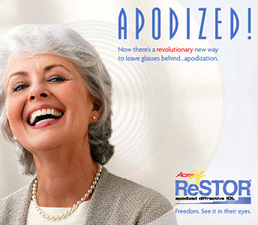About Premium Lens Implants.It's no secret that our eyes change as we age, and some problems - like the inability to read small print (presbyopia) and cataracts - are unavoidable. But now, thanks to recent advances in implantable intraocular lenses, we can turn back the time on aging eyes. Intraocular lenses (IOLS) are lens implants that are placed in the eye after the eye's natural crystalline lens is removed because of a cataract. Multifocal lens implants allow cataract patients to see clearly at a distance, as well as up close, giving them the freedom of better vision without the need for glasses. Say Good-bye to BifocalsIf you're of the baby-boomer generation, you're probably passing through the prime years for presbyopia - or "aging eyes." It's a condition that usually strikes after age 40 and makes it hard to see both near for reading and far for driving. While LASIK eye surgery improves vision, it's not considered the best treatment for presbyopia. Instead, multifocal implantable intraocular lenses are a great alternative. These lenses replace the eye's natural lens, helping you see both near and far. They provide relief for presbyopia and correct nearsightedness or farsightedness. LASIK, PRK, or ICL eye surgery is performed on patients who do not have cataracts. Once you develop cataracts (cloudy lenses in the eye), you may qualify for cataract surgery. Cataract surgery involves removal of the cataract and placement of an intraocular lens (IOL). Standard lenses are monofocal which gives each eye one focal point. With these implants, patients decide between far away vision or reading vision, not both. Or, one may choose monovision. Nowadays, there are multi-focal or accommodating intraocular lenses (IOLs) available that can be implanted in your eye at the time of cataract surgery. These are FDA approved and are also known as "Premium Lens Implants". The advantage of choosing this option is that these lenses give you a multi-focal outcome where you should be able to enjoy distance vision (e.g. driving) and close-up vision (e.g. computers) per eye. Each eye can focus at far-away distance and up-close distance giving you more independence from glasses and more range of vision and focus without glasses. New Cataract Surgery OptionsEach year, over two million people undergo cataract surgery to remove aging, cloudy eye lenses. Traditional cataract surgery replaces the cloudy lens with a single-focus intraocular lens, which only improves your distance vision. This means, following traditional cataract surgery, you might still need to wear reading glasses or bifocals to view things up close. The good news is the new multi-focal intraocular lenses can give you more than one focus. They not only treat cataracts but also restore your ability to see up close and at a distance. In fact, many people who have worn glasses or contacts for most of their lives can undergo cataract surgery and become totally free of glasses! We boast some of the most experienced New Jersey cataract surgeons in the region. Remember, your eyesight doesn't have to fade away with the years. To improve your vision, a surgeon can select from the number of different intraocular lens technologies available on the market today. Each uses a slightly different optical design. Call us for an evaluation and consultation to determine which type of intraocular lens is right for you. Traditional or Standard Intraocular Lenses (IOL)Traditional cataract surgery replaces the cloudy lens with a single-focus intraocular lens (lOL). This only improves your vision at one distance, usually for distance, and you will still need to wear reading glasses or bifocals to view things up close. Or, you may choose a single-focus IOL that only improves your reading vision and you will still need to wear glasses for distance vision. Some patients choose "monovision", to have one eye corrected for distance vision and one eye corrected for near vision. With any of these options, patients will still need to wear glasses for clear vision at all distances. Premium Lens ImplantsUntil recently, cataract patients had few choices for the implants used to restore their vision. They had to choose the traditional or standard implants. Now, you have several choices. These are called premium IOLS. They are designed to provide you with a mutli-focal range of vision thus making it possible for you to see far-away and up-close without glasses, allowing for decreased dependency on glasses after cataract surgery. Nowadays, there are multi focal or accommodating intraocular lenses (IOLs) available that can be implanted in your eye at the time of cataract surgery. These are FDA approved and are also known as premium IOLs. The advantage of choosing this option is that these lenses give you a multi focal outcome where you should be able to enjoy distance vision (e.g. driving) and close-up vision (e.g. computers) per eye. Each eye can focus at far-away distance and up-close distance giving you more independence from glasses and more range of vision and focus without glasses. There are several premium IOLs that are FDA approved and widely used in the U.S. These include the Crystalens, ReStor, and the Tecnis. Your surgeon will help you identify which lens is best for you. For more information, please click on the links to visit each company's website using the links on the right side of this page.
|
 (856) 667-3937Kindermann Eye Associates |
Eye Doctor South Jersey Kindermann Eye Associates - 3001 Chapel Avenue, Suite 200, Cherry Hill, New Jersey 08002Excellence in eye care for patients seeking a quality caring eye doctor in South Jersey. Dr. W Reed Kinderman is a premier ophthalmologist, New Jersey eye surgeon, specializing in cataract surgery, refractive surgery, laser guided cataract surgery, Tecnis multifocal lens implant, ReStor intraocular lens, Crystalens, Toric intraocular lens, glaucoma, strabismic eye muscle disorders, ophthalmology, and the full spectrum of eye care in New Jersey, Delaware Valley, Philadelphia, Mullica Hill, Ashland, Echelon, Thorofare, Riverton and surrounding areas. |
